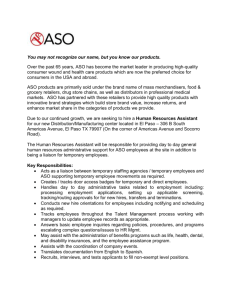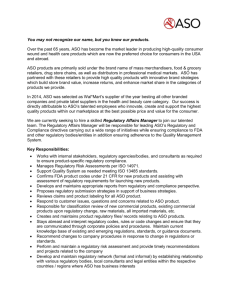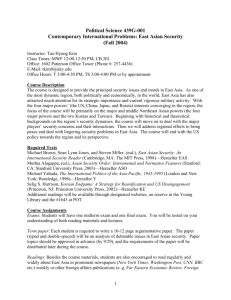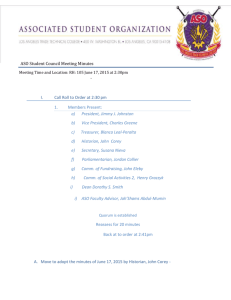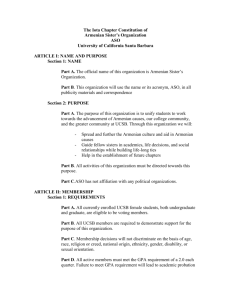Why Use the services of AlternAtive stAffing orgAnizAtions
advertisement
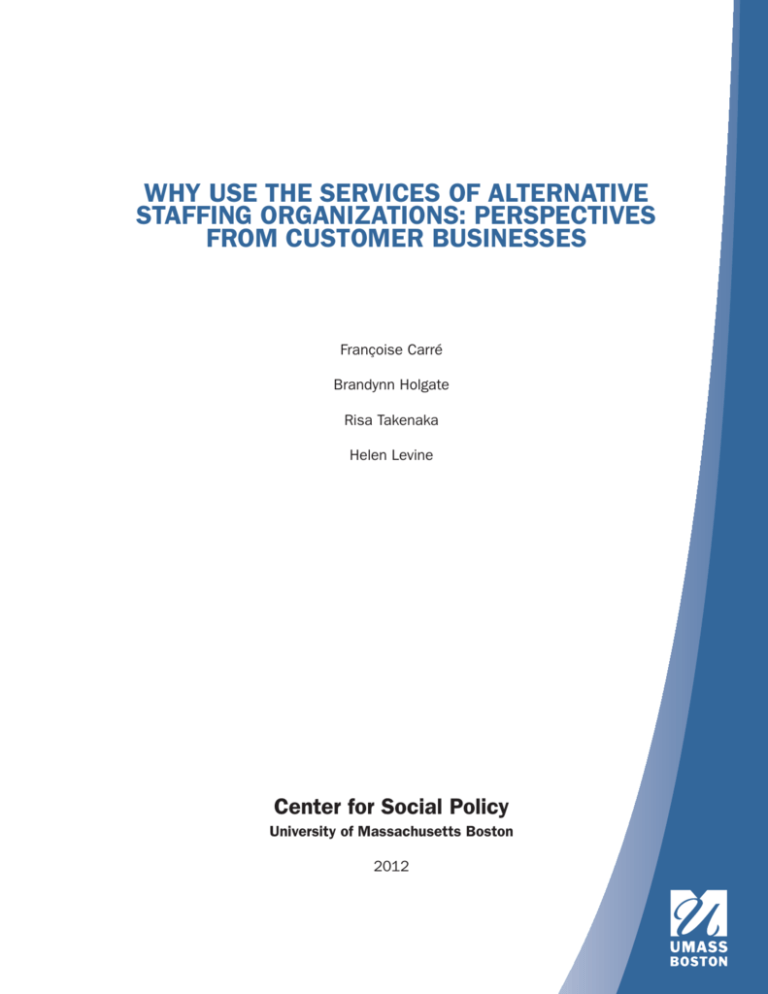
Why Use the Services of Alternative Staffing Organizations: Perspectives from Customer Businesses Françoise Carré Brandynn Holgate Risa Takenaka Helen Levine Center for Social Policy University of Massachusetts Boston 2012 introDUction Organizations that aim to improve the experiences and employment chances of job seekers who face barriers to employment have, over the years, had to contend directly with potential employers and their requirements. This is particularly true for community-based job brokers that use a temporary staffing model, offering job access and immediate work to their service population. Alternative staffing organizations (ASOs) are worker-centered, social purpose businesses that place job seekers in temporary and “temp-toperm” assignments with customer businesses, and charge their customers a markup on the wage of the position. These fee-for-service organizations can help job seekers who face labor market barriers gain work experience and access potential employers. Created by community-based organizations and national nonprofits, ASOs are often embedded within larger organizations that provide other employment, training, and human services to their community. The parent organizations may also be operating other social enterprise ventures. Businesses that contract ASOs for staffing services are customers that expect a service, but also represent an opportunity for employment and work experience for job seekers. Thus ASOs must operate with a dual agenda to serve both sides of the equation. In related publications (see Related Project Publications at end of this paper), we have explored how ASOs operate as social enterprises and how the model fits within the goals of the parent organization. With detailed information from five well-established ASOs, and as part of two waves of a demonstration initiated by the Charles Stewart Mott Foundation, we have documented 1 the employment experiences of workers placed in assignments and their employment status after leaving the ASO. (See box for details.) In this paper, we address engagement with businesses and their perspectives on ASO services. This is a major issue for ASOs as well as for other workforce development organizations. ASOs engage with businesses while selling staffing services and monitoring worker performance. By the very nature of temporary staffing, they receive rapid feedback on worker performance and their services from customer businesses. As such, ASOs provide a window into how to connect to potential employers in order to access opportunities. Also, activities of ASOs shed light on how hiring takes place for entry-level jobs, and how customer businesses use ASOs to solve their entry-level hiring problems. This paper demonstrates what can be learned from customers of established ASOs about their reasons for using these services. Specifically, it explores how customer businesses use temporary staffing by ASOs, and for what purposes. What business needs do they meet with ASO services? What are their reasons for using an ASO over conventional staffing agencies? And finally, what causes customer businesses to use an ASO and retain the service over time? These concerns are salient for those organizations considering the creation of an ASO. They also are important for workforce development programs that need to become more active in engaging potential employers and that seek solutions for job seekers who need to connect to employment and need immediate income. Why Use the Services of Alternative Staffing Organizations: Perspectives from Customer Businesses 1 the Alternative staffing Demonstration This paper is based on the Alternative Staffing Demonstration I and II, two monitoring and evaluation studies conducted by the Center for Social Policy from 2005 through 2009 and 2008 through 2011. The first study focused on the operations of participating ASOs and their customer businesses. The second study focused on outcomes for workers who used ASO services to find employment and on customer businesses that fi lled jobs through these services. The Alternative Staffing Demonstrations are part of an initiative launched by the Charles Stewart Mott Foundation (www.mott.org) which began in 2003. Three organizations participated in both studies: Emerge Staffing of Minneapolis, Minnesota; First Source Staffing (FSS) of Brooklyn, New York; and Goodwill Staffing Services (GSS Austin) of Austin, Texas. Goodwill Staffing Services of Boise and Nampa, Idaho (GSS Boise) participated in the first study only, while Goodwill Temporary Staffing (GTS Suncoast) of St. Petersburg, Florida participated in the second study. The studies entailed the collection of administrative data as well as four rounds of site visits. At each visit, staff interviews, a worker focus group, and an interview with a current customer business were conducted. interviews and types of customers As part of the research for the Alternative Staffing Demonstration, we interviewed current customer businesses of four ASOs in each of the two studies, a total of 34 interviews of customers across five ASOs (three took part in both waves of the demonstration). Representatives of customer businesses participated in interviews lasting 45 to 60 minutes that inquired about the conditions under which they use temporary placements and in which they use the services of an ASO, and why. All respondents and their companies were assured of anonymity. In order to have access to customer businesses, we relied upon initial contacts made by the ASO staff, usually the account executive or sales staff. It was not possible to contact former customers or businesses that had turned down sales efforts. As a result, the findings convey what current customers value in the ASO formula for staffing positions, usually entry-level positions. While current customers are, by definition, mostly satisfied customers (otherwise they would not retain the service), respondents were quite forthcoming about the strengths and limitations of the services provided them. 2 Who was interviewed? Customer businesses from a range of industries, reflecting the customer base of each of the ASOs, participated (Table 1). Among the 34 interviewees, 16 were for-profit customers, 10 were nonprofits, and 8 were state and local governments. Of all customers interviewed, 17 were local companies, 2 were national companies, 5 were multinationals, and the rest were state or local government offices. ASOs, like other staffing services, look for job placement opportunities in a range of industries with entry-level jobs, particularly trying to identify businesses with job openings that are suitable to the profi les of their job seekers. The customer base of each of the five ASOs in this study reflected where they made successful sales, and where they had developed steady business. Emerge Staffing accessed primarily blue-collar work in property maintenance and manufacturing, as well as positions in social service organizations. FSS accessed a range of white-collar and blue-collar positions in a wide array of private companies and social service organizations. Goodwill Staffing Services of Boise and Nampa provided staffing to public administrations, as well as construction and manufacturing companies. GTS Suncoast accessed private nonprofit organizations (e.g. health care-related) and for-profit companies, as Why Use the Services of Alternative Staffing Organizations: Perspectives from Customer Businesses table 1: industry of interviewed customer Businesses industry type number Building and property maintenance, property management, and janitorial 6 Business services (1 in waste management) 2 Education and Health Services, of which: Health care services Social assistance Other education and health services 2 2 3 Finance 1 Hospitality 1 Manufacturing (1 in precision manufacturing) 5 Professional, scientific, and technical services (communications) 1 Public administration (state and local government) 8 Other services (religious groups, grant making) 3 total 34 well as jobs within Goodwill social enterprises. GSS Austin operated the bulk of its business through a state disability set-aside contract that gave access to state and local government temporary positions to those vendors placing people who had qualifying disabilities (see Carré et al. 2009, 2011 for details). Patterns of Use and Business needs Businesses use ASO services, as they would use conventional staffing services, to save some of the transactional costs tied to hiring and firing. In other words, businesses use staffing services in order to bypass the recruiting and screening of job applicants, and in order to maintain an “arms’ length” relationship with workers. They are willing to pay a fee—that is, a markup on the hourly wage of the position—for the service. Importantly, they use ASO services over those of a conventional company for reasons directly influenced by how ASOs structure their services. Perhaps most striking is that businesses are prone to turn to ASOs when they are planning to eventually hire; they rely on the staffing service as a way to pre-screen potential hires. Conversely, they tend to use conventional and ASO services interchangeably when they need a short-term worker. Many customers interviewed, particularly those that are part of national or multinational corporations, use ASO services alongside those of mainstream companies. The conditions in which customers use ASO services can be characterized as follows: First, customer businesses use an ASO when they “staff up” (i.e., when they need to hire regular workers to cover increased activity or the opening of a new facility, or to replace workers lost through turnover). They use the ASO to recruit and screen workers, and then use the temporary assignment to assess the worker prior to regular hiring. In some cases, the arrangement is explicitly “tempto-hire” (as is the case with some FSS customers), but most often it is an implied expectation on both sides, and the ASO staff recruit in a particular way (for consistent job performance), grooming the job candidates to that end. A second pattern that represents a significant volume of activity is high-volume temporary staffing, a pattern also used very commonly in the case of conventional services. Here, the customer staffs an entire shift or staffs all entry-level positions through the ASO. This practice is found in light manufacturing and warehousing, and in cases where demand is seasonal or unpredictable. A third pattern can be characterized as the use of temporary staffing services for short-term gap fi lling. Few job assignments are generated this way, but when there is the need (particularly when the customer is new), such staffing may constitute a foot in the door for the ASO and for an individual.2 Finally, ASOs may be brought in because they can recruit populations targeted through public policy. State level disability set-aside programs, as the one in Texas, will give a first look at staffing vendors placing job seekers with a documented3 disability. Why Use the Services of Alternative Staffing Organizations: Perspectives from Customer Businesses 3 In other cases, a local company might meet a requirement for local hiring by partnering with the ASO to access workers from a local, economically disadvantaged community.4 The local market of each ASO provides a context for the patterns of use we have just described. For example, in our most recent study5 each of four participating sites staffed distinctive types of jobs, showing that customers use ASO services for specific positions.6 • Most customers of Emerge Staffing were “heavy users” of building services/security positions; 55 percent of customers had over two-thirds of temporary jobs staffed by Emerge for these types of positions. • For First Source Staffing, 63 percent of customers were heavy users of FSS temporary jobs in clerical/office/sales positions. Another 23 percent of FSS customers were heavy users of FSS temporaries in maintenance and production jobs. • At Goodwill Staffing Services Austin, 76 percent of customers were heavy users of GSS temporaries in clerical/office/sales positions. • Finally, for Goodwill Temporary Services Suncoast, 50 percent of customer businesses were heavy users of GTS Suncoast temporaries for maintenance/production/other labor positions. Another 17 percent were heavy users of GTS Suncoast temporaries for clerical/office/ sales positions. More generally, the patterns of use of ASO services must be put into the broader context of the use of temporary staffing services. Previous research has shown that the use of temporary staffing is driven by an interest in deploying labor only as needed—for example to cover short-term needs, but also when workload is variable and somewhat unpredictable. Importantly, conventional staffing is also used to avoid carrying workers on payroll and to maintain an “arms’ length” relationship with workers.7 It is also a tool to pre-screen candidates in view of potential hiring and to extend probationary periods. In this context, firms rely on temporary staffing because their own ability to select candidates is limited due to small human resource departments and insufficient 4 recruitment capability. A common, and important, reality is that firms who use temporary staffing save on benefit costs8 because they usually do not provide and do not fund benefits (health insurance or paid time off ) for temporary workers. Another disturbing aspect of this reality is that, in some urban markets in particular, some conventional staffing services—day labor operators in particular—have been associated with violation of the minimum wage, overtime, and worker compensation laws.9 This broader context is important because it colors how firms will evaluate alternative staffing services, and make decisions about using an ASO over a conventional staffing company. Why companies Use Aso services Beyond patterns of use, there are reasons why customer businesses choose to use an ASO rather than a conventional staffing company and rather than conducting recruitment on their own. We find that customers can provide useful insight into two aspects of hiring behavior. First, they provide insight into what employers cannot do, or choose not to do, for themselves in terms of entry-level hiring. Second, they also provide insight into what mainstream temporary staffing does not do for employers regarding entry-level hiring. In short, we find that, for these customers, the ASO services solve difficulties they encounter with entry-level hiring. These difficulties include identifying appropriate job candidates, and finding a job broker that pays close attention to the specific needs of the business and the qualifications of the temporary workers. While these services are well within the purview of conventional staffing services, the reality for these customer businesses is that they cannot receive these services for entry-level, low-skilled positions from the conventional companies they have encountered. Also, these customers find it too burdensome to screen job candidates for hiring. ASOs facilitate temporary and longer term hiring for these customer businesses. For example, small and midsized companies with limited HR capacity noted they relied on the candidate screening provided Why Use the Services of Alternative Staffing Organizations: Perspectives from Customer Businesses by the ASO because they could not perform it themselves. Also, small offices of larger companies found it necessary to have screening tailored to their specific, local needs, something they could not secure either from HR or from the main staffing vendor to the corporation. not strikingly different from that of candidates encountered through direct hiring—most came from a similar neighborhood—but that, with the ASO worker, there was information about the worker and supports to enhance worker performance. solving the Problem of entry-level hiring Where mission and market meet Foremost, customers report that it is the ASO’s attention to their business needs that singles out the services that a particular ASO provides them. This attention includes effort by the ASO staff to customize the service as well as their knowledge of the work setting and their responsiveness to requests for adjustments. Customer businesses notice the commitments of the ASO to job access and, hopefully, to a more stable employment experience for workers. While some engage the ASO services because of a sense of social responsibility, or a compelling local policy, most do not. Customization is mentioned frequently in terms of the quality of candidate screening and job matching. By it, customer businesses mean several dimensions: actual customization (“[they] tailor the situation to us individually”)10; and staff investment in the service (“[they] care about the effort and the outcome”).11 But customers also consider knowledge of their business environment and specific needs as customization. The following statement illustrates these considerations: “They know and understand how [our organization] operates, so they know what we needed.” (2010) This attention to their constraints also hints at the lack of customization customer businesses encounter in other staffing services with which they have dealt. Of particular note is the fact that ASOs conduct assessment and background checks (which day labor companies may not do). Whenever necessary, they also disclose the specific background of an ex-offender (nature of the offense) in order to help dispel resistance to hiring and to bypass blanket policies blocking the hiring of ex-offenders. These customers seem to have encountered difficulties with other staffing services, which has prompted them to seek an alternative. For example, one noted of the ASO it used: “They didn’t just send me anybody. They knew what we were looking for” (2009). Also, some customers noted that the background of ASO workers was However, while mission may not come into play in their decision to contract with the ASO, customers recognize that mission drives the quality of the service they receive. Many customers draw the connection between the motivation to have the worker succeed in the job assignment with the quality of the job match. For example, one noted: “He [the staffing coordinator] has a good insight into the people he hires and that he sends to us.” (2009) Customers recognize that the orientation to securing access to employment for at-risk workers underlies the type of customer service that the ASO staff provides. The responsiveness of ASO staff to customer concerns is often quoted as a factor in retaining the ASO as vendor (and crucial for the ASO to retain business). In addition, customers noted a “sense of ownership” on the part of staff and also said that follow-up with them, postplacement, was more consistent than they had encountered before. Importantly, these customers retain the ASO as vendor even if their markup is higher than that of a day labor pool and their turnaround on fi lling assignment is a little longer. The reliance of these customers—albeit a small group in the vast staffing industry market—on ASOs for screening and preparing temporary workers in view of regular entry-level hiring indicates to us the difficulties they experience with entry-level hiring. In essence, for these satisfied customers, ASOs provide a higher quality staffing service for entry-level, low wage workers because ASOs, themselves, need the worker to succeed. In turn, the customer businesses benefit from this Why Use the Services of Alternative Staffing Organizations: Perspectives from Customer Businesses 5 enhancement to their hiring process. All of these functions are also performed by mainstream staffing services and advertised by them. However, these types of services are not delivered consistently by mainstream companies when they staff low-end positions, and never by day labor companies. Likely, this is because the lowend of the mainstream staffing industry achieves financial results through high-volume, low-margin strategies. With high volume, customizing is not possible. Allusions were made to day labor operators in particular, with statements that can be paraphrased as “the last we hear from them is when they drop off workers …until the invoice.” In contrast, a representative of a human service company employing direct care workers noted the contrast with her company’s interaction with mainstream agencies: “….it saves me an inordinate amount of time. Very few agencies will help you like that. You know, you call up and they just send somebody out…they [ASO] do a lot more detailed screening…” (2008) A satisfied ASO customer made a colorful statement about the contrast between the ASO approach, motivated by a need to place the worker successfully, and that of large staffing companies which handle far greater numbers of workers: “I’ve dealt with big national [temp agencies]. I’ve dealt with your smaller local ones…. being that they were a commercial entity, they were more interested in placing people and making money versus providing me with the best quality candidate for the position. That may be the biggest difference…it seems that maybe [the ASO’s] main goal is to help people move forward in their lives versus necessarily deriving income for a company.” (2010) Another way in which the mission of the ASO may mesh with the needs of customers is that these businesses have encountered difficulty with conducting their own hiring, as noted earlier. One customer business who hired technicians for telecommunications installation found that the workers recruited through the ASO had better retention than higher skilled technicians directly recruited through the open market because technicians for this high growth industry are very mobile. This customer was better off recruiting 6 employees through the ASO and relying on his company’s training organization to prepare them. In this case, and in specific cases where the workers placed were ex-offenders, retention was partly due to the difficulty that these workers have experienced finding work on their own. Awareness of the social mission Observers and practitioners in the workforce development field might wonder whether social mission matters to customer businesses, because whether it does or not would affect how an organization might approach selling ASO services to potential customers. ASOs as a whole, and participating sites in this study are no exception, range widely in their use of the social mission— facilitating access to employment for people facing barriers—in securing customer accounts. Some of the ASOs in the study may not highlight their connection to a community agency, for example, preferring instead to blend into their local market, although in all cases service quality was emphasized as a primary selling point. As a result, we encountered a range of awareness and explicit interest in the mission of the ASO. Sometimes, awareness of the multi-faceted barriers that workers have faced is dim: “My impression of most of the employees… and candidates they’ve brought us [is] that being unemployed isn’t their only issue” (2009). In other cases, customer business representatives did not mention the social mission in their comments. Awareness of the mission of the ASO was more prevalent when the ASO provided a very visible and valuable service, like transportation to the worksite, something that Emerge Staffing of Minneapolis does. It was also more prevalent in areas where the ASO was connected to a wellknown community agency or in cases where the customers themselves were social service agencies. Also customers in state agencies in Austin were aware that GSS workers had a qualifying disability. The connection to helping people access work was sometimes the factor that triggered openness to the ASO’s sales effort. As one customer noted “…[this particular ASO] was attractive to me because while we may be providing them some Why Use the Services of Alternative Staffing Organizations: Perspectives from Customer Businesses assistance now, it had an end [in] sight to it in that that person became independent at some point.” (2010) coordinators, who must troubleshoot as they arise. Here we draw upon reports from ASO staff as well as those of customer businesses. More often, customer business representatives noted that they were aware that the worker was being supported in some way by the ASO, and the customer connected this level of preparation and support to the quality of the service received, as we highlighted in the previous section. One noted that giving someone a second chance mattered and that she would be willing to take “a 20-30% difference in costs” to do so and also get a better service (2009). For another, awareness of mission engendered a degree of accommodation not usually encountered among users of staffing services; this accommodation was possible because of the involvement of ASO staff in mediating workplace issues. A supervisor reported “I wanted to give them an opportunity, to give them a chance… So I did what I could. First I’d talk to them and if it didn’t improve, then I would involve [the ASO].” (2010). On some occasions, customer businesses do not renew the contract (i.e. ask for temporary workers) because the response time of the ASO is slower than they require. This is primarily because ASOs, being smaller organizations, do not have the vast reserve pool of ready job candidates that units of large staffing corporations do. Thus, customer account selection on the part of the ASO is also key, triggering a balancing act between securing job assignments and making sure the account can be retained over time. A contract to serve a large operation that needs to staff up quickly may be initially attractive because of the potential job opportunities it offers, but also may present challenges that the ASO cannot meet because the contract would require it to expand operations too quickly. Difficulties arise with carrying out recruiting and screening at the pace required. Conversely, for some customers, the wait provides a better match. One customer representative from a manufacturing company noted that she will call a conventional company when she needs to fi ll positions the “next morning” but will call the ASO because the wait “provides quality” for positions for which screening is important. While awareness of the social mission matters for some customers, it is important to underscore that in all cases, quality of service and of the job match are the overriding concerns. Still, at the level of direct engagement with workers, some supervisors mesh performance standards with a reckoning of social mission concerns. challenges of Providing consistent staffing services We have noted that the patterns of use of ASOs we witnessed were driven by the specific needs that businesses have, particularly regarding entry-level hiring. This pattern is also partly driven by the fact that ASOs seek customers that have a growing job base to increase the likelihood of their service population landing a regular (“permanent”) job as a result of a temporary placement. Much can also be learned about challenges that workers and ASO staff encounter during the delivery of services. Some of these difficulties can be anticipated and many can be addressed by the ASO staff. Those that are not anticipated become the day-to-day responsibility of staffing Also, given the competitive environment of the staffing industry, there is also a risk of loss of business triggered by workers. Inadequate performance or attendance by one worker on assignment may trigger concern about the ASO as a whole and result in the loss of the customer account. More commonly, ASOs encounter a range of challenges in delivering staffing services, which they do address when they are “fi xable.” Mismatches of skills between worker and job can usually be addressed, and mismatches between job requirements and personal temperament can also be addressed. (ASO staff will report that such mismatches can be anticipated and avoided if the customer’s work setting is already familiar to them.) Mismatches occasionally occur because time constraints have shortened the screening process. For example, a worker Why Use the Services of Alternative Staffing Organizations: Perspectives from Customer Businesses 7 on assignment might not meet the criteria; a customer noted “He’s sitting right next to me and telling someone he doesn’t know how to use a [software] program” (2007). Mismatches are addressed with re-assignments and customer business representatives indicate that they have encountered similar occurrences with conventional staffing as well; for them, the deciding factor in retaining the ASO over another staffing company is the lower frequency of mismatch. More challenging to deal with are “intangibles” or situations difficult to anticipate. For example, one ASO reported that young workers, mostly men, found a short-term assignment necessitating dexterity, steady hands, and patience challenging. More difficult to anticipate and address are cultural style differences, a by-product of the spatial distribution of jobs. One ASO found that sending well-prepared inner city workers to a clerical work setting located in an ex-urban office and with an existing workforce recruited mostly from a rural environment proved too wide a cultural divide to breach. Among day-to-day unpredictable situations to manage, staffing coordinators encounter job requirements that are different from what the customer described at the time of the contract, a situation that occurs for conventional staffing services as well. They also encounter customerbased supervisors who can present difficult working styles that must be explained to ASO workers. The translation of workplace norms and expectations for ASO workers is an ongoing responsibility. Also, workers themselves give rise to unanticipated difficulties; these may be due to, for example, complications in their personal and family life or because of a lapse in medication. Individual workers also may fail on the job due to behavioral difficulties. Thus, the range of challenges encountered is wide and ever changing. As a result, ASO staff have acquired significant knowledge about workplaces and supervisory styles. In established ASOs, the staff have also developed a range of skills in troubleshooting and worker coaching, as well as 8 handling day to day interactions with supervisors and managers who are their most direct contact with the customer business. conclusion Organizations which serve people who face barriers to employment encounter an ongoing challenge of achieving productive engagement with potential employers. The experience of alternative staffing organizations, as documented in our studies, points to productive ways to engage potential employers as customers of a staffing service. The experience of ASOs is particularly relevant for organizations that seek to place job seekers who are neither ready for training programs that would pave the way for community college enrollment, nor eligible for serviceintensive employment preparation programs. For these organizations and their service population, an entry-level job has a place as a step in a worker’s employment trajectory. Therefore, securing entrylevel opportunities and assessing their quality are important, hence the need for direct engagement with potential employers. ASOs have engaged potential employers primarily by selling them staffing services, which in turn create paths to work experience and employment for job seekers who face labor market barriers. We find that the primary decision point for customer businesses hinges on the quality of the staffing service provided them. Nevertheless, given this priority, we find that the distinctive way in which ASOs provide services solves difficulties of entrylevel hiring for employers while being motivated by the social mission of the ASO, which emphasizes worker success. For the workforce development field in particular, ASOs provide insight into employer decisions and ways of engagement with organizations driven by social mission. It is reasonable for an organization to expect that potential employers do not value the social mission, yet there are times when social mission matters to them, either directly or indirectly. It matters directly when a customer business representative values putting employment and income back into the local community or when the business faces a local Why Use the Services of Alternative Staffing Organizations: Perspectives from Customer Businesses hiring requirement as part of a public contract award. Social mission matters indirectly because it drives the ASO staff to pay particular attention to the job match and to worker performance while on the job. In turn, this approach enhances the service and prompts employer interest. Thus, employer engagement with the social mission of the ASO may be achieved indirectly and moves beyond a simple company platform of “social responsibility.” Instead, these customer businesses engage with the ASO because its approach to job brokering services is distinctive, adds value to the performance of their business, and also connects to the improvement of economic conditions in the community where they are located. endnotes 1 2 3 Th is paper is a product of the Alternative Staffing Demonstration, funded by the Charles Stewart Mott Foundation, which benefited greatly from the collaboration and input of many individuals and organizations. We are grateful to all for their insights, their willingness to share their experiences, and their longstanding commitment to helping others find work and succeed at it. At the University of Massachusetts Boston Center for Social Policy, the research team benefited from the leadership of Dr. Donna Haig Friedman, Director. The paper was edited by Leslie Vryenhoek. The layout and text were designed by Cynthia Metallides. Occasionally, customers use the ASO for sheer payrolling of an entire function—a common use of conventional temporary staffing but a rare one for ASOs. They rely on the ASO more to administer basic HR functions (e.g. payroll) but less to actually screen job candidates. To qualify under this program, job seekers must undergo a process of verification of their disability under statedefined criteria, thus obtaining “qualifying disability” status. 4 A recycling company used the ASO workers as a condition for receiving a city recycling contract. 5 Carré et al. 2011. 6 For this analysis, we computed the number of customers which had over two-thirds of their job assignments with the ASO in a given occupational group (e.g. clerical). We then calculated the share of the ASO’s customer base that this number represents. The computation was carried out for major occupational groupings. Th is analysis was carried out for 186 customer businesses for which information on job type of assignments was available for the 2009-2010 period. 7 Cappelli, Peter, Laurie Bassi, Harry Katz, David Knoke, Paul Osterman, and Michael Useem. 1997. Change at Work. New York: Oxford University Press. 8 Houseman, Susan N. 2001. “Why Employers Use Flexible Staffing Arrangements: New Evidence from an Employer Survey.” Industrial and Labor Relations Review 55, No. 1: 149-70. 9 Peck, Jamie and Nikolas Theodore. 1998. “The Business of Contingent Work: Growth and Restructuring in Chicago’s Temporary Employment Industry.” Work, Employment and Society 12: 655-74. 10 All quotations in this paper are from interviews of customers of the ASOs who participated in interviews between 2005 and 2010, as described in the Introduction. 11 Carré et al. 2009. Why Use the Services of Alternative Staffing Organizations: Perspectives from Customer Businesses 9 Related Project Publications: Available at: http://www.umb.edu/csp/publications/ reports/ Alternative Staffing Organizations and Skills: Linking Temporary Work with Training. 2012. Brandynn Holgate, Françoise Carré, Helen Levine and Risa Takenaka. Center for Social Policy, University of Massachusetts Boston. The Alternative Staffing Work Experience: Populations, Barriers and Employment Outcomes. 2012. Helen Levine, Brandynn Holgate, Risa Takenaka, and Françoise Carré. Center for Social Policy, University of Massachusetts Boston. Finding the Right Fit: How Alternative Staffing Affects Worker Outcomes. 2011. Françoise Carré, Brandynn Holgate, Helen Levine with Balaji Kanachi, Risa Takenaka, and Elizabeth Tov. Center for Social Policy, University of Massachusetts Boston. Brokering Up: The Role of Temporary Staffing in Overcoming Labor Market Barriers. 2009. Françoise Carré, Brandynn Holgate, Helen Levine, and Mandira Kala. Center for Social Policy, University of Massachusetts Boston. About the Center for Social Policy The Center for Social Policy provides expertise on policies and practices that reduce social and economic inequities. The Center accomplishes this through active engagement with policymakers, researchers, service providers, and those affected by policies and policy analysis. The Center for Social Policy is part of the John W. McCormack Graduate School of Policy and Global Studies at the University of Massachusetts Boston. In carrying out its projects, the professional staff collaborates with faculty and graduate students from the University. Center for Social Policy John W. McCormack Graduate School of Policy and Global Studies University of Massachusetts Boston 100 Morrissey Boulevard Boston, MA 02125 Tel: 617-287-5550 Fax: 617-287-5566 www.csp.umb.edu © 2012 Center for Social Policy, University of Massachusetts Boston
